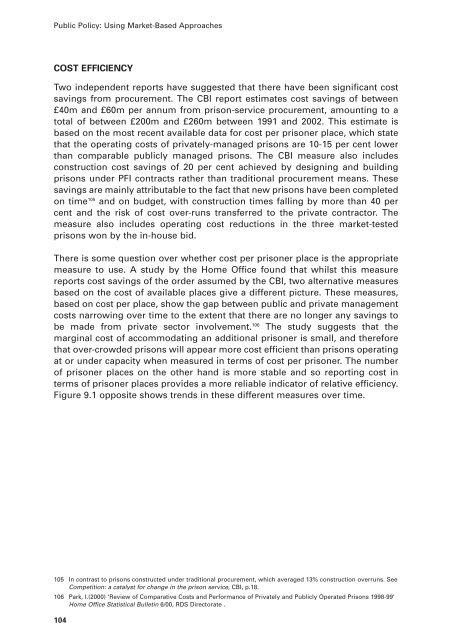Public Policy: Using Market-Based Approaches - Department for ...
Public Policy: Using Market-Based Approaches - Department for ...
Public Policy: Using Market-Based Approaches - Department for ...
You also want an ePaper? Increase the reach of your titles
YUMPU automatically turns print PDFs into web optimized ePapers that Google loves.
<strong>Public</strong> <strong>Policy</strong>: <strong>Using</strong> <strong>Market</strong>-<strong>Based</strong> <strong>Approaches</strong><br />
COST EFFICIENCY<br />
Two independent reports have suggested that there have been significant cost<br />
savings from procurement. The CBI report estimates cost savings of between<br />
£40m and £60m per annum from prison-service procurement, amounting to a<br />
total of between £200m and £260m between 1991 and 2002. This estimate is<br />
based on the most recent available data <strong>for</strong> cost per prisoner place, which state<br />
that the operating costs of privately-managed prisons are 10-15 per cent lower<br />
than comparable publicly managed prisons. The CBI measure also includes<br />
construction cost savings of 20 per cent achieved by designing and building<br />
prisons under PFI contracts rather than traditional procurement means. These<br />
savings are mainly attributable to the fact that new prisons have been completed<br />
on time 105 and on budget, with construction times falling by more than 40 per<br />
cent and the risk of cost over-runs transferred to the private contractor. The<br />
measure also includes operating cost reductions in the three market-tested<br />
prisons won by the in-house bid.<br />
There is some question over whether cost per prisoner place is the appropriate<br />
measure to use. A study by the Home Office found that whilst this measure<br />
reports cost savings of the order assumed by the CBI, two alternative measures<br />
based on the cost of available places give a different picture. These measures,<br />
based on cost per place, show the gap between public and private management<br />
costs narrowing over time to the extent that there are no longer any savings to<br />
be made from private sector involvement. 106 The study suggests that the<br />
marginal cost of accommodating an additional prisoner is small, and there<strong>for</strong>e<br />
that over-crowded prisons will appear more cost efficient than prisons operating<br />
at or under capacity when measured in terms of cost per prisoner. The number<br />
of prisoner places on the other hand is more stable and so reporting cost in<br />
terms of prisoner places provides a more reliable indicator of relative efficiency.<br />
Figure 9.1 opposite shows trends in these different measures over time.<br />
105 In contrast to prisons constructed under traditional procurement, which averaged 13% construction overruns. See<br />
Competition: a catalyst <strong>for</strong> change in the prison service, CBI, p.18.<br />
106 Park, I.(2000) ‘Review of Comparative Costs and Per<strong>for</strong>mance of Privately and <strong>Public</strong>ly Operated Prisons 1998-99’<br />
Home Office Statistical Bulletin 6/00, RDS Directorate .<br />
104
















